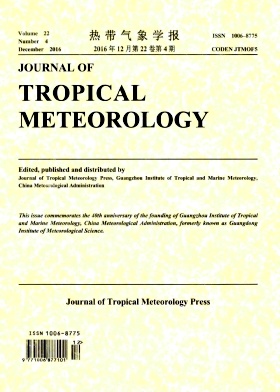OBSERVATIONAL STUDY ON THE PRE-TROPICAL CYCLONE SQUALL LINE OF 8 AUGUST 2007 OVER THE COAST OF SOUTH CHINA
doi: 10.16555/j.1006-8775.2016.04.006
- Rev Recd Date: 2016-09-14
Abstract: A squall line in front of the tropical cyclone Pabuk occurred in the west of the Pearl River Delta to Zhanjiang on August 8th, 2007 when the storm approached South China. The development, structure and environmental conditions for this squall line were investigated in this study, with particular attention paid to the possible connection of this squall line with Pabuk. The observational data employed in this study are from soundings, Doppler weather radars and wind profile radars. The following six major conclusions are drawn by our observational analyses. (1) This squall line developed gradually from individual convective cells, and land breeze may be responsible for the onset of the squall line. (2) The path and intensity of the squall line were modulated by the environmental conditions. The squall line propagated along the coastline, and it was stronger on the landing side of the coastline compared with the surrounding in-land regions and oceanic regions. (3) The typical characteristics of tropical squall lines were seen in this squall line, including the cold-pool intensity, vertical structure and the wake flow stratiform precipitation at its developing and mature phases. (4) The environmental conditions of this squall line resemble those of tropical squall lines in terms of deep moist air and low convection condensation level. They also resemble mid-latitude squall lines in terms of the convective instable energy and vertical wind shear in the lower troposphere. (5) Two roles were played by the strong wind around Pabuk. On the one hand, it made the atmosphere more unstable via suppressed shallow convection and increased solar radiation. On the other hand, it enhanced the land-sea thermal contrast and therefore strengthened the sea breeze and the resultant water vapor transport. The sinking temperature inversion prevented the occurrence of low-layer weak convection and accumulated convection instability energy for the development of the strong convection.
| Citation: | ZHENG Teng-fei, HUANG Jian, WAN Qi-lin, et al. OBSERVATIONAL STUDY ON THE PRE-TROPICAL CYCLONE SQUALL LINE OF 8 AUGUST 2007 OVER THE COAST OF SOUTH CHINA [J]. Journal of Tropical Meteorology, 2016, 22(4): 508-521, https://doi.org/10.16555/j.1006-8775.2016.04.006 |

















 粤公网安备 4401069904700002号
粤公网安备 4401069904700002号
 DownLoad:
DownLoad: